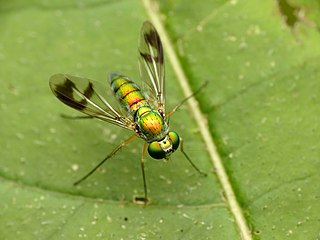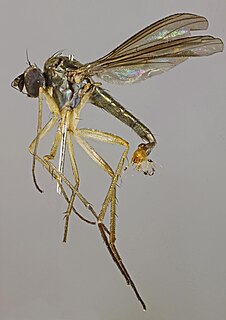Achalcus is a genus of flies in the family Dolichopodidae.

Amblypsilopus is a genus of flies in the family Dolichopodidae. It is a large genus, with about 350 species recorded. However, it is possibly polyphyletic.
Asyndetus is a genus of flies in the family Dolichopodidae. There are more than 100 species described for the genus, distributed worldwide.

Condylostylus is a genus of flies in the family Dolichopodidae. It is the second largest genus in the subfamily Sciapodinae, with more 250 species included. It has a high diversity in the Neotropical realm, where 70% of the species occur.
Dactylonotus is a genus of flies in the family Dolichopodidae. Six of the species in the genus are found in southern Africa, though one species, Dactylonotus formosus, is found in New Zealand.
Ethiosciapus is a genus of flies in the family Dolichopodidae.

Lichtwardtia is a genus of fly in the family Dolichopodidae. It is considered to be a synonym of Dolichopus by Scott E. Brooks (2005), but not by other authors. Before this, it was considered a possible subgenus of Pterostylus by Oleg Negrobov (1979).

Medetera is a large genus of flies in the family Dolichopodidae.

Sybistroma is a genus of flies in the family Dolichopodidae. It includes over 50 species, described mainly from the Palaearctic and Oriental realms. A single species is known from the Afrotropical realm. Until 2005, the genus was thought to be restricted to the Mediterranean in distribution, with five known species. It was recently expanded to include the former genera Hypophyllus, Ludovicius and Nordicornis, as well as some species of Hercostomus.

Syntormon is a genus of flies in the family Dolichopodidae. It includes about 110 species worldwide, more than 50 of which were described from the Palaearctic realm.
Systenus is a genus of fly in the family Dolichopodidae.
Telmaturgus is a genus of flies in the family Dolichopodidae. It has a cosmopolitan distribution.

Dolichopodinae is a subfamily of flies in the family Dolichopodidae.

Medeterinae is a subfamily of flies in the family Dolichopodidae.

Peloropeodinae is a subfamily of flies in the family Dolichopodidae. According to Germann et al. (2011), the subfamily is polyphyletic.

Gymnopternus is a genus of flies in the family Dolichopodidae. It was formerly placed as a subgenus of Hercostomus, but is now accepted as a separate genus.
Afrohercostomus is a genus of flies in the family Dolichopodidae. Many of the species were formerly from "Hercostomus Group I", one of three groups of Afrotropical Hercostomus species created by Igor Grichanov in 1999.










